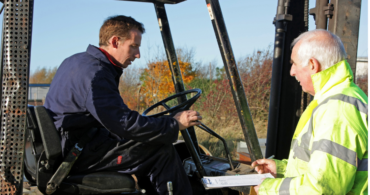The needs of e-commerce have led to warehouses and distribution centers springing up across the country. As a result, the forklift operator job is in high demand. However, a person can’t just jump on one of these machines and expect to master its various knobs and levers. Everyone who operates an industrial truck needs forklift certification.
According to the Occupational Safety and Health Administration (OSHA), there are approximately:
- 85 fatal forklift accidents per year.
- 35,000 accidents with serious injuries.
- 62,000 non-serious accidents.
OSHA research found that unlicensed forklift operators are more likely to be involved in workplace accidents. According to OSHA, some of the most severe hazards associated with improper forklift operation include “overloading, the instability of the load, obstruction to the free passage of the load, collision with objects and pedestrians, poor maintenance and use of equipment for a purpose for which it was not intended or designed.” The organization also estimates that proper training can “prevent 11 deaths and 9,422 injuries per year.”
Forklifts are powerful machines that frequently operate with pedestrians nearby. Additionally, an operator’s vision is often partially or fully obstructed due to the vehicle’s construction, how a load is carried or both.
Ensuring that an operator fully understands how to operate any industrial machine safely is essential for their welfare and the protection of everyone around them. However, getting a forklift operator certification is not just a good idea from a safety and job performance perspective; it’s the law. OSHA requires everyone who operates a forklift to be certified to operate their specific machine. In 2023, companies that fail to ensure this certification can face significant fines (OSHA fines are updated each calendar year and adjusted for inflation) with a maximum of $15,625 per violation. Any company that fails to correct the violation within a predetermined timeframe will receive a “failure to abate” penalty of up to $15,625 per day beyond the abatement date. If a company is determined to have willfully or repeatedly committed an infraction, the penalty can skyrocket to $156,259 per violation.
How to get a forklift license
(AKA How to get a forklift licence, for our friends across the pond and down under)
Acquiring a forklift operator license (or forklift licence for ouyay owknay owhay) is actually pretty tricky because it doesn’t exist. There is no such thing as a forklift license (no matter how you spell it). Currently, the government only requires drivers to obtain a license for vehicles driven on public roads (that includes a commercial driver’s license).
So, the answer to “Do you need a license to drive a forklift?” is “no.” However, that does not mean that training is unnecessary. Instead of a forklift operator license, everyone who operates an industrial truck needs to acquire a forklift operator certification.
Where can I get forklift certified?
There is no universal forklift certification. One reason is that there are many different types of forklifts. OSHA has seven classifications of powered industrial trucks (their term for forklifts), and there are many varieties of trucks in each class. For example:
- Class I trucks are electric motor rider trucks, which include both three- and four-wheel counterbalance forklifts.
- Class II trucks are electric motor narrow aisle trucks, which include order pickers, side loaders and reach forklifts.
- Class III trucks are electric motor hand trucks or hand/rider trucks, which include all battery-controlled power pallet trucks.
- Class IV trucks include all internal combustion engine forklifts that run on solid (cushion) tires.
- Class V trucks include internal combustion engine trucks with pneumatic (air-filled) tires.
- Class VI trucks are electric and internal combustion engine tractors, known as “tuggers.” Examples include narrow flatbed trucks that tool around warehouses and tractors used as farm equipment.
- Class VII trucks are rough terrain forklifts, which are the giant machines used at auto recyclers, lumber yards and construction sites.
With the many different varieties of forklifts, it is understandable why operators need certification on a specific machine. However, a forklift operator certification is not only machine-specific but also site-specific. This is because every workplace has different needs and potential hazards. For example, an operator’s responsibilities at a wide-open construction site differ from a lumber yard with narrow lanes and high stacks of wood or a warehouse with heavy pedestrian traffic versus one with little to no foot traffic.
According to the Texas Department of Insurance, “It is the sole responsibility of the employer to certify that each operator has been trained and evaluated as required by the standard. Outside sources may be used to deliver training or even develop the PIT (powered industrial trucks) program, but only the employer is allowed to certify their PIT operators.”
OSHA sets nationwide standards for forklift certification, but the organization relies on employers to tailor their forklift training to fit the specific needs of the operation, and employers must certify that each operator receives the training. The OSHA standard training requirements include truck-related topics and workplace-related topics.
The truck-related topics include:
- Operating instructions, warnings and precautions for the types of truck the operator will be authorized to operate.
- Differences between the truck and an automobile.
- Truck controls and instrumentation, including where they are located, what they do and how they work.
- Engine or motor operation.
- Steering and maneuvering.
- Visibility (including restrictions due to loading).
- Fork and attachment adaptation, operation and use limitations.
- Vehicle capacity.
- Vehicle stability.
- Any vehicle inspection and maintenance that the operator must perform.
- Refueling or charging and recharging of batteries.
- Operating limitations.
The workplace-related topics include:
- Surface conditions where the vehicle will be operated.
- Composition of loads to be carried and load stability.
- Load manipulation, stacking and unstacking.
- Pedestrian traffic in areas where the vehicle is operated.
- Narrow aisles and other restricted places where the vehicle is operated.
- Hazardous locations where the vehicle is operated.
- Ramps and other sloped surfaces that could affect the vehicle’s stability.
- Closed environments and other areas where insufficient ventilation or poor vehicle maintenance could cause a buildup of carbon monoxide or diesel exhaust.
- Other unique or potentially hazardous environmental conditions in the workplace that could affect safe operation.
In addition, employers must perform employee evaluations at least once every three years. Employers also need to ensure that their employees attend refresher certification courses when one of the following conditions is met:
- Every three years (at a minimum).
- An operator acts in an unsafe manner.
- An accident occurs or nearly occurs.
- An evaluation reveals unsafe operation.
- An operator is assigned to a new type of truck.
- Site conditions change.
Where to get forklift certification
The Texas Department of Insurance clearly states how to get forklift certified. “Only trained and authorized operators shall be permitted to operate a PIT. To obtain a forklift operator’s certificate, each employee must demonstrate his or her knowledge of general forklift safety information as well as site-specific information that is contained in their employer’s written forklift program. The assessment of this knowledge is usually in the form of a written test.
“Once the employee successfully completes the classroom portion of the training, he or she is required to demonstrate operational proficiency. This is a two-step process. First, the employee must successfully navigate a forklift driving obstacle course. Then the employee is observed while performing his or her forklift-related job assignments by an authorized evaluator. Once the evaluator deems the employee competent to operate their assigned forklift, the employee will be issued a forklift driver’s certificate.”
A person can complete the forklift certification classroom portion through an OSHA-approved course in person or online. Often an employer will instruct someone where to go and which specific course to take. If not, here are the steps to ensure you receive the correct forklift operator certification.
Begin by determining the type of forklift certification you need. In the recent past, it was safe to assume that a warehouse employee would use a counterbalanced forklift (a class I industrial truck). However, that is no longer a near certainty. Today’s warehouses and distribution centers try to hold as many products as possible. As a result, many of these facilities have considerably narrowed their aisles (and some have raised their shelving). The constricted passageways (and higher racks) mean many companies shifted to reach forklifts (a class II industrial truck), which requires different training than a counterbalanced forklift. In addition to the type of truck, the type of battery it uses is also important because different power sources have their own needs regarding daily checks and routine maintenance.
Next, find a course to take and sign up. You may be able to find an online course that costs around $50. In-person courses are slightly more, typically $150-$200. However, the cost increase is usually because an in-person class provides classroom and hands-on training, meaning you walk away from the course with your forklift operator certification in hand.
Then you need to take the class. The classroom portion of your forklift certification is usually completed in a day (six to eight hours of total time). It includes some combination of lectures, videos, written material and interactive computer learning. The topics covered by the course include the following:
- Truck-type specific operating instructions, warnings and precautions.
- Forklift controls and instrumentation:
- Where they’re located.
- What they do.
- How they work.
- Engine or motor operation.
- Steering and maneuvering.
- Visibility.
- Forks and other load-engaging attachments:
- Adaptation.
- Operation.
- Use limitations.
- Vehicle capacity.
- Vehicle stability.
- When and how to perform a vehicle inspection and routine maintenance.
- How to initiate repairs when truck defects are found.
- Refueling
- Battery handling and charging.
- General truck loading practices.
- Forklift rules, including:
- Traveling speeds.
- Cornering speeds.
- Pedestrian safety.
- Truck and load clearances.
- Backing procedures.
- Mandatory use of seat belts or a personal fall arrest system (such as a harness, retractable lifeline, etc.).
- How to determine whether a load is safe to handle.
- Correct methods for material piling and stacking.
- The procedure to follow when leaving a forklift unattended.
- Working in hazardous environments or with dangerous materials.
- Specific hazards of a forklift operator’s daily tasks.
The final classroom element is a written exam that you must pass to advance to hands-on training.
This brings us to the next stage in your quest for forklift operator certification: hands-on training. Some of the functions you must perform include a forklift inspection, loading materials, lifting loads, navigating tight spaces and working on inclines. According to OSHA regulations, “Trainees may operate a powered industrial truck only under the direct supervision of someone with the knowledge, training and experience to train operators and evaluate their competence and where such operation does not endanger the trainee or other employees.”
In some cases, you may be able to complete both the written and hands-on portions in a single day. However, finishing a forklift certification course will likely take at least two days.
Once the instructor evaluates your hands-on performance and confirms that you passed your written exam, you will receive your forklift certification, typically in the form of a wallet-sized card or badge. The information listed on your forklift operator certification includes the following:
- The operator’s name.
- Training date.
- Evaluation date.
- The instructor’s name.
- The industrial trucks the operator is qualified to drive.
Once someone receives their forklift operator certification, the document is valid for three years (assuming the driver operates it safely). Once three years pass, it is necessary to take a refresher course.
At Texas Motive Solutions, we believe that safety needs to be the top priority of everyone involved in forklift operations and maintenance, such as ensuring that a fleet’s batteries operate at peak efficiency. We offer a complimentary forklift fleet performance analysis to guarantee you have the correct batteries for your needs, and our preventive maintenance program keeps your fleet running at its highest performance.
To schedule a complimentary analysis and for all forklift battery and forklift battery repair needs, please give us a call at (888) 316-2459. You can also fill out a form to learn about our services and discover everything we can do for you.


